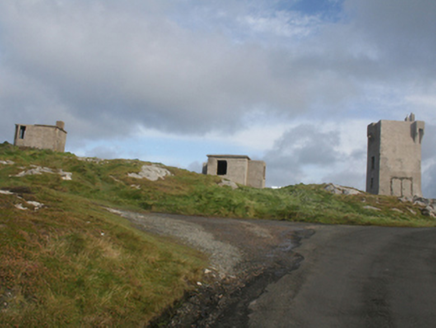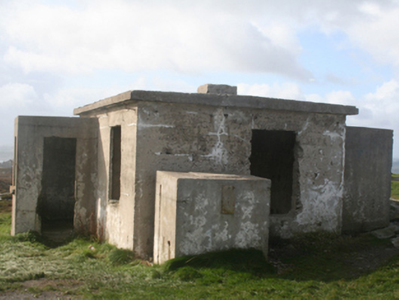Survey Data
Reg No
40900113
Rating
Regional
Categories of Special Interest
Architectural, Historical, Scientific
Previous Name
Lloyds Signal Tower
Original Use
Telegraph station
Date
1880 - 1920
Coordinates
239730, 459589
Date Recorded
29/06/2012
Date Updated
--/--/--
Description
Detached single-bay single-storey former semaphore and\or telegraph station, built c. 1900, having projecting single-bay single-storey porches to the north and south elevations. Now ruinous and out of use. Flat reinforced concrete roof with concrete base of former radio mast to centre. Reinforced concrete walls having square-headed window openings, fittings now gone. Square-headed doorway to the east elevation of porch to the south, fittings now gone. Detached two-bay single-storey structure to the east having flat reinforced concrete roof and walls, and square-headed door and window openings (fittings now gone). Located in a prominent elevated location on an elevated site close to the north end of Malin Head, and adjacent to the former Napoleonic-era signal tower (see 40900101) and a World War Two-era watchman’s hut (see 40900104).
Appraisal
This unassuming and utilitarian building is a structure of considerable historical interest. It may have been originally built as a semaphore station by the insurance company Lloyds of London when information on shipping arriving across the Atlantic (Lloyds of London underwrote the insurance for many transatlantic shipping ventures) was passed from a semaphore station on the offshore island of Inishtrahull (see 40900214), and to and from shipping to Malin Head, and eventually on to London. Later, c. 1900, Guglielmo Marconi (1874 – 1930) established a radio signal station here, and this structure was probably built at this time. In 1902 Marconi succeeded in sending the first commercial radio message to a ship, the S.S. Lake Ontario, from this station on Malin Head. Apparently the radio station was involved in the sea trials of the radio system on the ill-fated RMS Titanic in April 1912. Later the station was taken over by the Post Office for communication purposes, c. 1909. Although now out of use and derelict, this former telegraph station is highly significant in the development of radio. It is located adjacent to the site of a former Napoleonic-era signal tower (see 40900101) and a later World War Two-era watchman’s hut (see 40900104), which attests to a long running strategic interest in this location. The simple and equally unassuming structure to the east\south-east also probably dates to this time and adds to the setting and context.



